Hello Guys My Name is Ayan From CBSEMeterials – Free CBSE Study Meterials and Today I am going to share The Age of Industrialization Class 10 Notes [Part 2] For Free and Which Helps you in Getting Good Marks in CBSE Class 10 History Chapter 4 Summary . You can also download The Age of Industrialization Class 10 Notes PDF For Free of Cost. So without further ado, let’s get to the Class 10 Summary of The Age of Industrialization Class 10 Notes [Part 2]
Contents
hide
Other Parts of The Age of Industrialization Class 10 Notes
Quick Review of The Age of Industrialization Class 10 Notes
- A music book with a picture of a goddess-like figure holding the flag of the new century and standing on a wheel with wings to symbolise time and her flight into the future was published in 1900 by popular music publisher E.T. Paull.The symbols of development—a railway, camera, machineries, printing press, and factory—float about behind her.
- The tale of industrialization is one of growth, and the present era is one in which technological advancements have taken place.
- Before factories in England and Europe were built, there was a significant amount of industrial production for a global market. Not based on factories, this. These days, a lot of historians call this stage of industrialization proto-industrialization.
- In this early form of industry, instead of factories a large majority of producers worked on their family farms and were under the direction of merchants.
- Following the Industrial Revolution, modern machinery and steam power replaced animal and manual labour in the production of goods. During the revolution, factories took the place of the cottage industry.
- Around England, the first factories were established in 1730.
- The cotton mill was built by Richard Arkwright. Cotton and metals were two of Britain’s most active industries.
- Cotton was the dominant industry in the early stages of industrialization up until the 1840s, expanding quickly.
- Factory workers were the name given to the industrial workers. The average worker in the middle of the nineteenth century was a seasoned labourer and craftsperson.
- Textiles were a vibrant industry, but a significant amount of the output was produced outside, in home units.
- India controlled the global textile market with its silk and cotton products before the advent of machines in the workplace.
- Industrialization happened quickly. It is obvious for the reasons listed below:
- During the early stages of industrialization, cotton was the dominant industry.
- The textile industry was thriving.
- Many non-mechanized industries, including food processing, building, pottery, glass work, tanning, furniture manufacturing, and implement production, grew as a result of common and small innovations.
- Technological advancements were gradual. They did not significantly spread throughout the industrial landscape.
- Due to the growth of the cotton industries in England, the business interests pushed the government to put import taxes on cotton textiles out of concern about foreign imports.
- The businessmen also convinced the East India Company to market British goods in India.
- Thus, cotton weavers in India had to deal with two issues at once:
- Their export industry fell apart.
- Due to Manchester imports, the local market shrunk.
- Cotton supplies from the US were cut off when the Civil War started, so Britain turned to India.
- The increase in raw cotton exports from India caused price inflation, which negatively affected weavers who were short of supplies and were compelled to pay exorbitant prices for raw cotton.
The Rise Of Nationalism In Europe Notes
- [ Part 1] The Rise Of Nationalism In Europe Class 10 Notes
- [ Part 3] The Rise of Nationalism in Europe Class 10 Notes
- [Part 2] The Rise of Nationalism in Europe Class 10 Notes
Flowchart of The Age of Industrialization Class 10 Notes
![[Part 2] The Age of Industrialization Class 10 Notes | The Age of Industrialization Class 10 Notes PDF 1 The Age of Industrialization Class 10 Notes](https://www.cbsemeterials.com/wp-content/uploads/2022/11/Screenshot_2-1.png)
Important Terms of The Age of Industrialization Class 10 Notes
- Industrialization : An economy changes from being predominantly agricultural to one based on the production of goods through the process of industrialization.
- Proto-industrialization : prior to or at the start of industrialization
- Industrial Revolution : The industrial revolution that saw factories take the place of cottage industries.
- Spinning Jenny : James Hargreaves created this device in 1764. It increased spinning speed while lowering labour requirement.
- Gomasthas : They were the salaried servants that the East India Company assigned to oversee weavers, gather supplies, and assess the fabric’s quality.
Nationalism in India Notes
- [ Part 1] Nationalism in India Class 10 Notes
- [ Part 2] Nationalism in India Class 10 Notes
- [ Part 3] Nationalism in India Class 10 Notes
Important Dates of Terms of The Age of Industrialization Class 10 Notes
- 1600 : The East India Company was founded.
- 1730 : In England, the first factories were built.
- 1764 : The Spinning Jenny was created by James Hargreaves.
- 1771 : The first cotton mill was built by Richard Arkwright.
- 1776 : “Mule” was created by A.D. Crompton. It was a cross between a cotton mill and a Spinning Jenny.
- 1781 : The steam engine was patented by James Watt.
- 1781 : The new steam engine model was made by Mathew Boulton.
- 1830-1840s : In Bengal, Dwarkanath Tagore founded six joint stock enterprises.
Conclusion of The Age of Industrialization Class 10 Notes
Thank You for Reading The Age of Industrialization Class 10 Notes .I Hope the Chapter The Age of Industrialization Class 10 Notes PDF Solution Created by Cbsemeterials.com Team May Found Helpful for Your Class 10 Exam Preparation. If Found Any Error or Suggestion Please to Let Us Know



